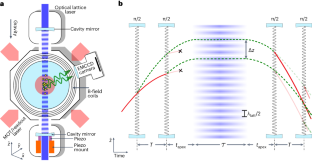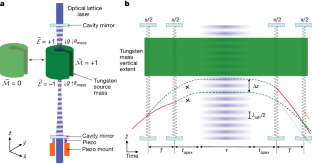2024-06-26 カリフォルニア大学バークレー校(UCB)
<関連情報>
- https://news.berkeley.edu/2024/06/26/with-a-new-incredibly-precise-instrument-berkeley-researchers-narrow-search-for-dark-energy/
- https://www.nature.com/articles/s41586-024-07561-3
- https://www.nature.com/articles/s41567-024-02518-9
格子原子干渉計で重力引力を測定する Measuring gravitational attraction with a lattice atom interferometer
Cristian D. Panda,Matthew J. Tao,Miguel Ceja,Justin Khoury,Guglielmo M. Tino & Holger Müller
Nature Published:26 June 2024
DOI:https://doi.org/10.1038/s41586-024-07561-3
Abstract
Despite being the dominant force of nature on large scales, gravity remains relatively elusive to precision laboratory experiments. Atom interferometers are powerful tools for investigating, for example, Earth’s gravity1, the gravitational constant2, deviations from Newtonian gravity3,4,5,6 and general relativity7. However, using atoms in free fall limits measurement time to a few seconds8, and much less when measuring interactions with a small source mass2,5,6,9. Recently, interferometers with atoms suspended for 70 s in an optical-lattice mode filtered by an optical cavity have been demonstrated10,11,12,13,14. However, the optical lattice must balance Earth’s gravity by applying forces that are a billionfold stronger than the putative signals, so even tiny imperfections may generate complex systematic effects. Thus, lattice interferometers have yet to be used for precision tests of gravity. Here we optimize the gravitational sensitivity of a lattice interferometer and use a system of signal inversions to suppress and quantify systematic effects. We measure the attraction of a miniature source mass to be amass = 33.3 ± 5.6stat ± 2.7syst nm s−2, consistent with Newtonian gravity, ruling out ‘screened fifth force’ theories3,15,16 over their natural parameter space. The overall accuracy of 6.2 nm s−2 surpasses by more than a factor of four the best similar measurements with atoms in free fall5,6. Improved atom cooling and tilt-noise suppression may further increase sensitivity for investigating forces at sub-millimetre ranges17,18, compact gravimetry19,20,21,22, measuring the gravitational Aharonov–Bohm effect9,23 and the gravitational constant2, and testing whether the gravitational field has quantum properties24.
格子原子干渉計における1分スケールのコヒーレンス限界 Coherence limits in lattice atom interferometry at the one-minute scale
Cristian D. Panda,Matthew Tao,James Egelhoff,Miguel Ceja,Victoria Xu & Holger Müller
Nature Physics Published:11 June 2024
DOI:https://doi.org/10.1038/s41567-024-02518-9

Abstract
In quantum metrology and quantum simulation, a coherent non-classical state must be manipulated before unwanted interactions with the environment lead to decoherence. In atom interferometry, the non-classical state is a spatial superposition, where each atom coexists in multiple locations as a collection of phase-coherent partial wavepackets. These states enable precise measurements in fundamental physics and inertial sensing. However, atom interferometers usually use atomic fountains, where the available interrogation time is limited to around 3 s for a 10 m fountain. Here we realize an atom interferometer with a spatial superposition state that is maintained for as long as 70 s. We analyse the theoretical and experimental limits to coherence arising from collective dephasing of the atomic ensemble. This reveals that the decoherence rate slows down markedly at hold times that exceed tens of seconds. These gains in coherence may enable gravimetry measurements, searches for fifth forces or fundamental probes into the non-classical nature of gravity.




